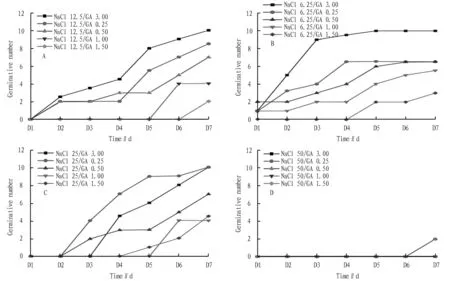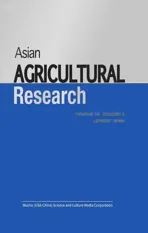Effect of Exogenous Gibberellin on Wheat Seed Germination under Salt Stress
2023-08-30TuredingAbudurousuliBaotongLIAizemaitiTuerhong
Tureding Abudurousuli, Baotong LI, Aizemaiti Tuerhong
Hetian Vocational and Technical College, Hetian 848000, China
Abstract [Objectives] In this experiment, wheat seeds were treated with different concentrations of gibberellin and different concentrations of salt solution to study the change of germination index of wheat seeds. [Methods] The germination rate, germination potential and germination index of wheat seeds were measured by routine methods, and the effect of exogenous gibberellin on germination of wheat seeds under salt stress was observed. [Results] The germination rate, germination potential and germination index of wheat seeds under salt stress were significantly increased after exogenous treatment of 0.25 and 0.50 g/L gibberellin within the range of salt concentration gradient. However, when the concentration of gibberellin was too high, it would inhibit the germination of seeds. [Conclusions] Appropriate concentration of gibberellin can effectively alleviate the stress caused by salt on wheat seed germination. In this experiment, the best concentration of gibberellin to alleviate salt stress was 0.25 g/L.
Key words Gibberellin, Salt stress, Wheat seed, Seed germination
1 Introduction
Soil salinization is one of the main abiotic stresses in agricultural production, having a serious impact on the growth cycle of crops and hindering the normal growth and development of plants[1]. High concentration of salt will reduce the environmental water potential, and the water potential, osmotic potential, pressure potential and relative water content of seedling leaves will obviously decrease, resulting in physiological drought and osmotic stress to cells[2]. Studies have shown that seed germination is the initial process of plant life, and it is also the earliest growth stage that can receive stress signals[3]. Compared with other growth stages, seed germination is more susceptible to adverse effects of adversity stress. In order to adapt to salt stress, plants need to maintain the balance between their developmental signals and responses to stress. Chemical plant hormones have specific effects on regulating seed germination, and play different roles in different growth stages, tissues or environmental conditions[2, 4]. Therefore, it is of great significance to deeply understand the functions of plant hormones for improving the salt tolerance of plants.
GA3is a compound that can promote cell division and elongation, and plays a vital role in the growth and development of plants. Its most significant physiological effect is to promote plant growth[5]. External application of GA3can accelerate the release of seed dormancy and promote seed germination, but excessive use will have adverse effects on the normal growth of seeds[6]. It has been reported that GA3at a certain concentration can significantly improve the germination rate of soybean (GlycinemaxL. Merr.)[7], rice (OryzasativaL.)[8]and corn (ZeamaysL.)[9]under salt stress, and the effect is remarkable. Taking wheat seeds as the object of study, the purpose of this study was to investigate the germination and seedling growth of wheat seeds by applying GA3to wheat seeds under salt stress, and to provide a theoretical support for producing high-quality wheat varieties in protected soil under severe salt stress.
2 Materials and methods
2.1 MaterialsSeeds: Wheat seeds are provided by Xinjiang Hongheyuan Agriculture Co., Ltd.
2.2 Pre-treatmentThe seeds of full wheat varieties were selected, washed with distilled water for 2-3 times, and finally placed in a culture dish, wrapped with sealing glue, and placed in a constant temperature incubator at 28 ℃. Wheat seeds were divided into different groups (Table 1), each group containing 20 seeds. Seeds were placed in culture dishes covered with double-layer filter paper, and different treatment solutions were added. The control group was treated with distilled water, and the treatment group was treated with 2.5 mL of salt solutions and 2.5 mL of different concentrations of GA3, and wheat seeds were treated at the same time. Each process was repeated twice. The germination of wheat seeds was observed and recorded every 24 h in a culture dish in an incubator at 28 ℃, and half of the seed length was taken as the standard to judge the germination. The number of buds was recorded every 24 h, and the germination rate, germination potential and germination index were calculated. The length of radicle and the fresh weight of germ and radicle of wheat seeds were measured on the 7thd.

Table 1 Wheat seed treatment
2.3 Determination of indexThe germination rate, germination potential, and germination index were calculated as follows:
Germination rate (%)=(Number of germinated seeds/Total number of tested seeds)×100%[10]
Germination potential (%)=(Number of germinated seeds on the fourth d/Total number of tested seeds)×100%[10]
Germination index=∑Gt/Dt
whereGtis the number of germinated seeds per day during the germination test period;Dtis the number of the corresponding seed germination days[10].
After the wheat seeds germinated to the end of the 10thd, the seedlings were cleaned with distilled water, and then the residual water on the surface was carefully absorbed with filter paper.
The length of radicle and germ was measured with 0.01 mm vernier caliper, and the weight of radicle and germ was measured with electronic analytical balance, repeated three times, and the average value was recorded.
2.4 Data processingUsing the SPSS 26.0 software and Excel software, the statistical analysis and the difference significance analysis were carried out, and the Excel software was used to carry out the drawing.
3 Results and analysis
3.1 Effect of different concentrations of GA3on germination rate of wheat seeds under salt stressAccording to the statistics in Fig.1, when wheat seeds were treated with 6.25, 12.5 and 25 g/L NaCl, adding GA3with concentration ranging from 0.25 to 0.50 g/L could promote the germination rate. However, the germination rate of seeds increased first and then decreased. When the concentration of GA3solution increased to 0.50 g/L, the germination rate of wheat seeds of different varieties reached the maximum in different treatment periods, and there was a significant difference between the treatment group and the control group (P<0.05). However, when the concentration of GA3was further increased to 1.00 g/L, the germination rate decreased gradually,which indicated that high concentration of GA3would decrease its effect on promoting wheat seed germination. Under the treatment of high concentration salt stress (25 g/L), seeds germinated after 96 h, and did not germinate during the treatment period. However, after adding GA3, the germination rate of seeds was obviously improved. During the treatment period, when the salt concentration was set at 50 g/L, wheat seeds could hardly germinate.

Note: NaCl content, A: 6.25 g/L; B: 12.5 g/L; C: 25 g/L; D: 50 g/L.Fig.1 Daily germination number of wheat seeds under different treatments
3.2 Effect of different concentrations of GA3on germination index of wheat seedsTable 2 shows that exogenous GA3can obviously promote the germination of wheat seeds. When salt concentration was 12.5 and 25 g/L and GA3concentration was 0.25 and 0.50 g/L, wheat seeds germinated more and grew well. This indicated that in a certain salt range, proper amount of GA3can accelerate seed germination and plant growth. However, when the concentration of GA3exceeded 1.00 g/L, the germination number of wheat decreased. This may be due to the high concentration of GA3affecting seed germination.

Table 2 Mitigating effects of different concentrations of GA3 on germination potential of wheat seeds under salt stress
3.3 Effect of exogenous GA3on wheat germination under salt stressWith the increase of salt concentration, the root length of wheat was continuously inhibited, while exogenous GA3at a certain concentration would promote the radicle elongation of wheat seeds under salt stress (Table 3). When the concentration of GA3was 0.25 and 0.50 g/L, the root length and root number of wheat seeds under different degrees of salt stress increased gradually with the concentration of GA3. When the concentration of GA3exceeded 1.0 g/L, the root length of wheat decreased. When the salt concentration was 6.25 g/L, its fresh weight was equivalent to that of the control group. However, the fresh weight decreased with increasing salt concentration, and no matter what concentration of GA3was applied, no germination occurred when salt concentration was 50 g/L. The fresh weight of radicle and hypocotyl of wheat seeds exposed to the stress of NaCl concentrations of 6.5, 12.5 and 25 g/L increased under exogenous GA3. When the concentration of GA3was 0.25 g/L, the fresh weight of wheat under salt stress increased most obviously compared with the control group, and with the increase of GA3concentration, the fresh weight also increased. However, when the concentration of GA3exceeded 0.50 g/L, the fresh weight of GA3decreased.

Table 3 Effect of different concentrations of GA3 on wheat germination under salt stress
4 Conclusions and discussion
The results showed that with the increase of salinity, the germination rate, germination potential and germination index of wheat seeds all showed a downward trend. In this experiment, wheat seeds could not germinate when the salinity was 50 g/L. Adding 0.25 g/L GA3to different concentrations could alleviate the stress of wheat under different salinity gradients to a certain extent, and effectively improve the germination rate and seedling growth. When the concentration of GA3was 0.25 g/L, the ability of alleviating salt stress was the best, and the application rate should be determined according to the specific situation in practical application. GA3alleviated the adverse effects of salt stress on wheat seed germination and seedling growth. However, under salt stress, whether GA3can regulate the metabolic pathway of wheat seedlings and whether it has the same regulatory effect on the later growth of wheat still needs further study.
杂志排行
Asian Agricultural Research的其它文章
- Impact of Sharp Fluctuations of Live Pig Prices on Financial Capacity of Pig Breeding Enterprises: An Analysis Based on the Data of Listed Enterprises from 2018 to 2021
- Construction of the "Three-integration" Rolling Development Mode in the Urban-rural Fringe from the Perspective of Thematic Business Engine: A Case Study of "Zhucheng Dinosaur Eco-city" in Shandong Province
- Relationship between Rural Industry Revitalization and Land Resource Utilization and Its Practice in Ganning Town, Wanzhou District of Chongqing
- Pollination Effects of Pear Trees by Honeybee and Its Influencing Factors
- Intellectual Property Protection and High-Quality Development of Xinjiang Melons under the Big Food Concept
- Age Structure and Change Trend of Tobacco Farmers: A Case Study of Shashi Town, Liuyang City, Hunan Province
